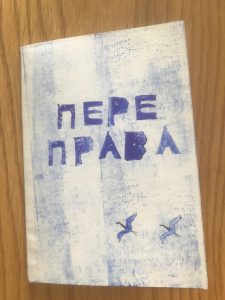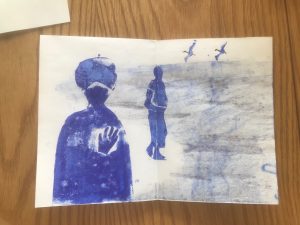That I have no idea when I will go to Guinea again makes me acutely nostalgic. I am now following an online bookmaking class, which I took because for ages I have had this plan of making a book about Guinea, about my hosting family, about the now 10-year experience of going there. The book I initially planned was more a traditional book with text, and the model I had in mind was Josef Brodsky’s “Watermark“, a depiction organized in short sketches of a somewhat similar experience of escaping to the very same place in the same season for many years (“At night, infinity in foreign realms arrives with the last lamppost” — especially at nights as dark as in Guinea). For Brodsky it was Venice during acqua alta, for me it is the dry season in Nzerekore. To my great surprise (I should have prepared better) and anguish and procrastination, what I end up learning is a variety of visual techniques.
This little book, made in the carton gravure technique, is about the short trip my language consultant and I took to go to the north of the country in January 2019. We went to study the archives of the Catholic mission there, more specifically, the old mission of Saint-Alexis, a small village which is now technically part of a big mining town of Siguiri. Even now this Maninka village counts only a couple of Muslim families, being surrounded by the Muslim majority. From my previous explorations I knew the scale of the impact of Maninka on the Catholic register of Kpelle and Mano, one of the objects of my study. I also knew that there were historical links between the Maninka and Kpelle parishes, since the first missionaries to work among the Kpelle came from the North, by the very same road we took about a century later. The St Alexis parish is mentioned in their records: this is where they celebrated Immaculate Conception in 1913. I wanted to know what the Catholic register of Maninka looks like. While the core Mano prayers are word-to-word translations from Kpelle, I thought it would be curious to learn whether the Kpelle prayers are word-to-word translations from Maninka.
We spent about three days in Kankan and in Siguiri-St-Alexis, copying archives. I made a mental note that St-Alexis is probably a perfect site for a ling anthro research, if I were to be born again as a PhD student (and if there is someone looking for a topic, please get in touch). On the last day we went to see what the Niger river is like, flowing just behind the fields and gardens. Probably subconsciously this was the main reason for the visit: I had never seen the great Niger before, except quickly while crossing a bridge in Faranah, where it is too young still, nor had I been to that savanna land, flat as God’s palm.
Niger is huge, but during the dry season for someone who knows what Volga looks like it is relatively unimpressive, although the thought that just around the river bend there are hippos made it quite a bit more exciting. We decided to take a ride to the other side and back, on a boat driven by a gondoliero boy, the river being very shallow. (I wonder what they do during the rainy season.) We had hardly arrived when we were approached by a mother and a daughter who asked us whether we could give them a lift on the other side, where we had come from and where the town was: they were rushing to the hospital since the young woman had gone into labor. The boy drove back three times as fast I think.
I keep thinking about the young woman, I hope she and the baby are doing fine.
This is what the little book, “River crossing” (“Переправа” in Russian) is about.




